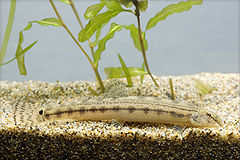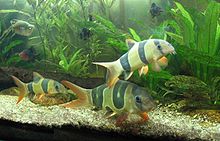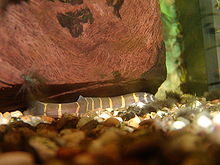- Cobitidae
-
Cobitidae 
Cobitis biwae (Cobitinae) Scientific classification Kingdom: Animalia Phylum: Chordata Superclass: Osteichthyes Class: Actinopterygii Subclass: Neopterygii Infraclass: Teleostei Superorder: Ostariophysi Order: Cypriniformes Superfamily: Cobitoidea Family: Cobitidae Subfamilies Cobitinae
BotiinaeCobitidae is the family of the true loaches, which are Old World freshwater fish. They occur throughout Eurasia and in Morocco, and inhabit riverine ecosystems. Today, most "loaches" are placed in other families (see below). But more than 100 species remain in the Cobitidae, while the number of genera has almost doubled to nearly 30 in the past few years[when?] due to new discoveries and divisions of older genera. New species are being described regularly.[1]
Contents
Description and ecology
The body forms of Cobitidae range from vermiform – worm-shaped, long and thin – to fusiform – spindle-shaped, cylindrical and tapering toward the ends. Most true loaches do not have true scales, and like many other Cypriniformes or catfishes, they have barbels at their mouths (usually 3-6 pairs). Some other traits typically found in this family are a small bottom-facing mouth suited to their scavenging benthic lifestyle, an erectile spine below the eye, and a single row of pharyngeal (throat) teeth.
True loaches are mostly scavengers and are omnivorous, usually not very picky about their food. They may eat aquatic crustaceans, insects and other small invertebrates as well as scraps of organic detritus. Many live in eutrophic waters of generally poor quality and feed on tubifex worms and similar benthos associated with such habitat. Some of these loaches have adapted to low oxygen levels in warm, muddy rivers or dirty ponds by being able to gulp up atmospheric oxygen from the air. Some species, particularly from the genera Cobitis and especially Misgurnus are sensitive to changing air pressure. They change their behavior accordingly, and as these changes in activity are usually followed by a change in weather, they are commonly known as "weatherfishes" or "weather loaches".
Because of their scavenging nature and their ability to adapt to many freshwater ecosystems, some Cobitidae have been introduced to foreign lands where they may pose problems to local wildlife as invasive species[verification needed][citation needed]. Other true loaches, many of them migratory fish, have been seriously affected by habitat destruction, chemical pollution and damming, and are considered threatened species today. Some migratory species are popular aquarium fish and since they are very hard to raise in captivity, overfishing has seriously depleted once-common stocks in several cases.
Systematics
The other "loaches" used to be included in this family, but nowadays are recognized as well-distinct members of the order Cypriniformes. Together with the suckers (Catostomidae), the "loaches" made up the superfamily Cobitoidea. However, the sucking loaches (Gyrinocheilidae) were easily recognizable as relatives of the suckers.[2]
Eventually it was realized that the hillstream loaches, though more similar to the true loaches than the other two presumed Cobitoidea, are nonetheless distinct enough to be better regarded a full-blown family Balitoridae. And as it seems the "sucking Cobitoidea" are quite distant indeed, perhaps even markedly closer to the Cyprinidae, and thus the old superfamily Catostomoidea warrants revalidation. Finally, the puzzling mountain carps were most often considered a distinct family Psilorhynchidae in recent times. But in a number of systematic schemes, they were placed in the Balitoridae (or Balitorinae, when these were included in the Cobitidae). In fact, they seem to be loachlike carps and belong in the Cyprinidae.[3]
The true loaches can be subdivided into two subfamilies, the typically fusiform Botiinae and the typically vermiform Cobitinae:
The Botiinae are the smaller subfamily, with 7 genera generally accepted today. Some of these are quite speciose however. The Cobitinae contain the remaining genera, but while a few make up the bulk of the remaining diversity of Cobitidae, many are very small or monotypic.
- Botiinae
- Botia
- Chromobotia
- Leptobotia
- Parabotia
- Sinibotia
- Syncrossus
- Yasuhikotakia
- Cobitinae
- Acanthopsoides
- Acantopsis
- Bibarba
- Canthophrys
- Cobitis
- Iksookimia
- Kichulchoia
- Koreocobitis
- Kottelatlimia
- Lepidocephalichthys
- Lepidocephalus
- Microcobitis
- Misgurnus – weatherfishes, weather loaches
- Neoeucirrhichthys – Goalpara Loach
- Niwaella
- Pangio (formerly Acanthophthalmus) – kuhli loaches
- Paralepidocephalus
- Paramisgurnus
- Protocobitis
- Sabanejewia
- Serpenticobitis
Use by humans
Some true loaches are popular as food fish in East Asian countries such as Japan. These are of importance in the fisheries or being raised in aquaculture. Small species may occasionally be caught for bait.
As aquarium fish
Many of the more brightly-colored species, in particular Botiinae, are popular with freshwater aquarists and are therefore of importance in the aquarium trade. The more colorful tropical species that are kept as pets are mainly South Asian and Southeast Asian Botiinae. Cobitidae often encountered in aquarium trade include:
- Clown Loach, Chromobotia macracanthus
- Dojo Loach, Misgurnus anguillicaudatus
- Horseface Loach, Acantopsis choirorhynchus
- Skunk Loach, Yasuhikotakia morleti
- Kuhli Loach, Pangio kuhlii
- Yoyo Loach, Botia almorhae
- Zebra Loach, Botia striata
- Bengal Loach, Botia dario
- Burmese Border loach, Botia kubotai
Cultural references
Loaches of some sort have been present in several video games:
- In the Nintendo 64 game The Legend of Zelda: Ocarina of Time, the largest fish you can catch is the "Hylian loach". Every time you enter the fishing pond as an adult in Ocarina of Time, there is a 1 in 4 (25 pc) chance this fish will be present in the pond. It has a long low dorsal fin unlike Cobitidae and looks much like a mix between a Misgurnus true loach and the Northern Snakehead (Channa argus) which is not a loach; both these fishes are quite familiar across East Asia.
- The Hylian loach is also present in the fishing minigame in Nintendo Gamecube/Wii game The Legend of Zelda: Twilight Princess.
- Loaches also appear in the Nintendo DS game Animal Crossing: Wild World and its Wii sequel, Animal Crossing: City Folk. They are small fish found in rivers from March to May. Not rare, one specimen sells for a mere 300 bells (as much as a black bass); thus it is apparently not – as the player character wonders when catching one – a Hylian loach. The icon, though very restricted in resolution, is a correct depiction of a Cobitinae loach with a color pattern resembling some East Asian species of Cobitis.
Shakespeare's Henry IV, Part 1 Act 2 has:
"Why, they will allow us ne'er a jordan, and then we leak in your chimney; and your chamber-lie breeds fleas like a loach."
This might be a misprint, or an obsolete term for a dovecote,[4] then as today notorious for "breeding" Ceratophyllus columbae fleas. Or it might indeed refer to the fish: the Spined Loach (Cobitis taenia), native to England, is very prolific, and the phrase can be taken to imply "...hosts fleas as abundantly as the Spiny Loach spawns".[5]
See also
Footnotes
References
- Absolute Shakespeare (AS) [2000]: King Henry IV, Part I Essay. Retrieved 2008-AUG-10.
- FishBase (2004): Family Cobitidae - Loaches. Version of 2004-NOV-22. Retrieved 2007-03-05.
- Steevens, George (1809): The Plays of William Shakespeare: With the Corrections and Illustrations of Various Commentators (Vol. 15: Hamlet, Timon of Athens). PDF fulltext at Google Books.
- He, Shunping; Gub, Xun; Mayden, Richard L.; Chen, Wei-Jen; Conway, Kevin W. & Chen, Yiyu (2008): Phylogenetic position of the enigmatic genus Psilorhynchus (Ostariophysi: Cypriniformes): Evidence from the mitochondrial genome. Mol. Phylogenet. Evol. 47: 419–425. doi:10.1016/j.ympev.2007.10.012 (HTML abstract)
- Nelson, Joseph S. (2006): Fishes of the World. John Wiley & Sons, Inc. ISBN 0471250317
External links
- FishBase treatment of the family
- Loaches on The Aquarium Wiki Category of common freshwater Loaches kept in aquariums
- Loaches Online - site with comprehensive information & discussions on keeping these fish in aquaria
Categories:- Cypriniformes
- Cobitidae
- Fish of Europe
- Fish of Asia
- Botiinae
Wikimedia Foundation. 2010.





